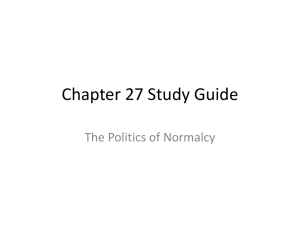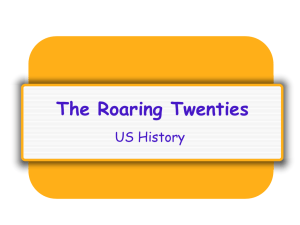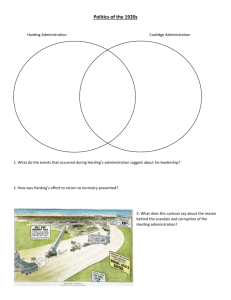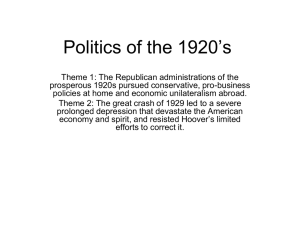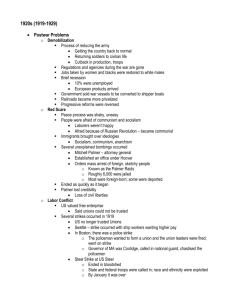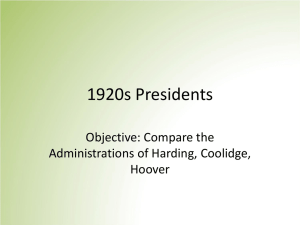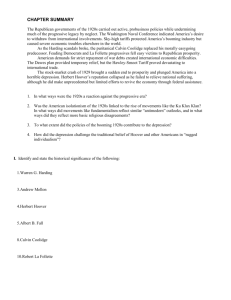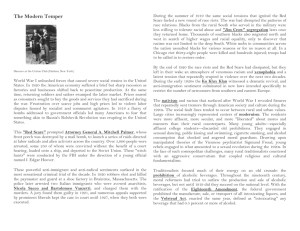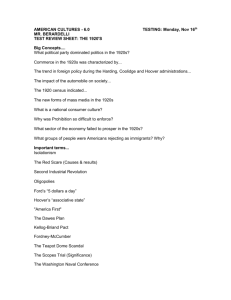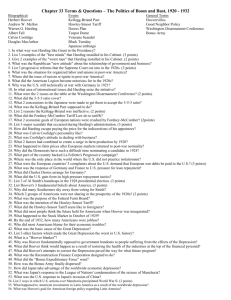“The Roaring 20s”
advertisement
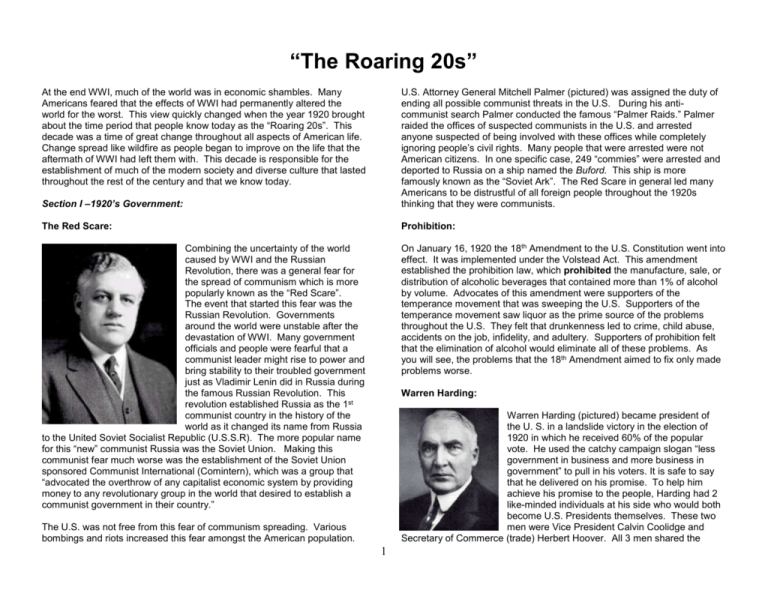
“The Roaring 20s” At the end WWI, much of the world was in economic shambles. Many Americans feared that the effects of WWI had permanently altered the world for the worst. This view quickly changed when the year 1920 brought about the time period that people know today as the “Roaring 20s”. This decade was a time of great change throughout all aspects of American life. Change spread like wildfire as people began to improve on the life that the aftermath of WWI had left them with. This decade is responsible for the establishment of much of the modern society and diverse culture that lasted throughout the rest of the century and that we know today. Section I –1920’s Government: U.S. Attorney General Mitchell Palmer (pictured) was assigned the duty of ending all possible communist threats in the U.S. During his anticommunist search Palmer conducted the famous “Palmer Raids.” Palmer raided the offices of suspected communists in the U.S. and arrested anyone suspected of being involved with these offices while completely ignoring people’s civil rights. Many people that were arrested were not American citizens. In one specific case, 249 “commies” were arrested and deported to Russia on a ship named the Buford. This ship is more famously known as the “Soviet Ark”. The Red Scare in general led many Americans to be distrustful of all foreign people throughout the 1920s thinking that they were communists. The Red Scare: Prohibition: Combining the uncertainty of the world caused by WWI and the Russian Revolution, there was a general fear for the spread of communism which is more popularly known as the “Red Scare”. The event that started this fear was the Russian Revolution. Governments around the world were unstable after the devastation of WWI. Many government officials and people were fearful that a communist leader might rise to power and bring stability to their troubled government just as Vladimir Lenin did in Russia during the famous Russian Revolution. This revolution established Russia as the 1st communist country in the history of the world as it changed its name from Russia to the United Soviet Socialist Republic (U.S.S.R). The more popular name for this “new” communist Russia was the Soviet Union. Making this communist fear much worse was the establishment of the Soviet Union sponsored Communist International (Comintern), which was a group that “advocated the overthrow of any capitalist economic system by providing money to any revolutionary group in the world that desired to establish a communist government in their country.” On January 16, 1920 the 18th Amendment to the U.S. Constitution went into effect. It was implemented under the Volstead Act. This amendment established the prohibition law, which prohibited the manufacture, sale, or distribution of alcoholic beverages that contained more than 1% of alcohol by volume. Advocates of this amendment were supporters of the temperance movement that was sweeping the U.S. Supporters of the temperance movement saw liquor as the prime source of the problems throughout the U.S. They felt that drunkenness led to crime, child abuse, accidents on the job, infidelity, and adultery. Supporters of prohibition felt that the elimination of alcohol would eliminate all of these problems. As you will see, the problems that the 18th Amendment aimed to fix only made problems worse. Warren Harding: Warren Harding (pictured) became president of the U. S. in a landslide victory in the election of 1920 in which he received 60% of the popular vote. He used the catchy campaign slogan “less government in business and more business in government” to pull in his voters. It is safe to say that he delivered on his promise. To help him achieve his promise to the people, Harding had 2 like-minded individuals at his side who would both become U.S. Presidents themselves. These two men were Vice President Calvin Coolidge and Secretary of Commerce (trade) Herbert Hoover. All 3 men shared the The U.S. was not free from this fear of communism spreading. Various bombings and riots increased this fear amongst the American population. 1 same view of the government’s role in business, a role that should be virtually non-existent. His economic views were great, but the possibility to achieve this view was put on hold when Harding inherited a country that was still feeling the effects of the recently ended WWI. Although the U.S. was not as bad off as Europe, having been the battleground of WWI, the U.S. was still suffering economically. While Europe was in the beginning stages of the Great Depression, the U.S. suffered from a “recession”. While a depression is the low point of the economic cycle when little or no economic activity is taking place, a recession is a short step above when economic activity slows down considerably. After experiencing a recession for over a year, in 1921 the U.S. economy got back on its feet. Harding himself called this change for the better a “return to normalcy” after the disruption caused by WWI. Although Harding got the U.S. back on its feet after WWI, his time in office was not very successful due to the fact that it was marked with corruption and scandal. Calvin Coolidge: Needing a president after the death of Harding, Vice President Calvin “silent Cal” Coolidge (pictured) was sworn into office. Harding’s scandalous administration left a “black mark” on the presidency and the Republican Party. Coolidge was given the task of restoring both, which was a task he more than fulfilled. When he first took office he took an isolationist stance on foreign policy vowing not to get involved in Europe’s problems as America did in WWI. Coolidge also continued Harding’s economic beliefs of keeping the government’s role in the economy limited. Having done well while filling in for Harding, Coolidge easily won the 1924 election. Herbert Hoover remained in his cabinet position as the Secretary of Commerce, and the economy continued to prosper without any help from the government. Harding’s Cabinet: Harding’s home state was Ohio, and many of his self-appointed cabinet members were also his close friends from Ohio. This helped his cabinet earn its 1st nickname, the “Ohio Gang”. Because they were also criticized for spending more time playing cards than planning national welfare for the country, Harding’s cabinet also earned a 2nd nickname, the “Poker Cabinet”. Harding was a good man from a small Ohio town, and often admitted how he was overwhelmed with the responsibilities that came with being the president of the U.S. Harding’s biggest problem was not controlling the country, but controlling his cabinet. On numerous occasions Harding’s closest friends and cabinet members betrayed him. Because of his cabinet friend’s betrayals, Harding is included the “scandalous presidents” category with names of Grant, Nixon, and Clinton. Many felt that Coolidge had a unique talent that contributed to his success, which was his talent of “effectively doing nothing”. Some historians point to the death of his son during his presidency as the reason for Coolidge’s silence due to suffering from some mild depression. Nonetheless, his leadership style was a perfect fit for the U.S. given the time period. As one politician said in 1926, “His active inactivity suits the mood and the certain needs of the country admirably. It suits all business interests which want to be left alone, and it suits all those who have become convinced that the government in this country has become dangerously complicated and topheavy (Red Scare).” A great story about Coolidge that supports his nickname “Silent Cal” takes place at a banquet. A lady sitting next to Coolidge explained that she had made a bet with a friend she could get him to say 3 words during the banquet. Coolidge responded to her by saying, “you lose”. Although successful during his time in office, Coolidge chose not to run for re-election in 1928. Teapot Dome Scandal: Of all the scandals during the Harding administration, the Teapot Dome Scandal is the most famous. In 1915 the U.S. set aside 3 oil fields as reserves for the nation’s future if an energy crisis were to occur. Secretary of the Interior, Albert Fall, managed to get the control of these reserves transferred to the Department of the Interior, which was the U.S department that he controlled. He then secretly leased, or rented, 2 of the reserves (Teapot Dome, Wyoming and Elk Hill, California) to 2 private oil companies in exchange for $325,000 in bonds and cash plus a large herd of cattle. Fall was forced to pay $100,000 fine and was sentenced to 1 year in prison. Shortly after the scandal, Harding died of a heart attack on August 2, 1923 1 year before his presidential term was up. Many of Harding’s closest friends point to his friend’s betrayals as the cause of his death. Herbert Hoover: After capably serving as Secretary of Commerce under both Harding and Coolidge, Herbert Hoover (pictured) was the logical choice to be the next U.S. president when Coolidge decided not to run for office in 1928. Because of the engineering degree he earned from the University of Stanford, Hoover was given the name the ‘Great Engineer”. Proof of 2 Hoover’s engineering talents lies in an engineering process that Hoover envisioned and would be responsible for starting when he became president. The finished product of this process is one of the greatest projects in U.S. history which is also fittingly named after him, the Hoover Dam. This went right along with the belief held by many Americans that Hoover was responsible for “engineering” the economic prosperity that took place during the 1920s due to his role as the Secretary of Commerce. Because of his reputation, Hoover won the 1928 election vowing to continue his ‘laissez-faire” capitalist economic policies. Below is a famous yet ironic quote said by Hoover shortly after he was elected president of the U.S. 10. What “movement” was prohibition a part of, and what were the aims of prohibition? 11. What was Harding’s presidential campaign slogan in 1920? 12. What was Europe in the beginning stages of after WWI? Give an educated guess as to why. 13. Explain the difference between a depression and a recession. 14. Explain what Harding meant by the phrase “return to normalcy”. 15. What were the 2 nicknames given to Harding’s cabinet? 16. Explain the Teapot Dome Scandal. 17. How did Coolidge gain his first presidential term? “We in America today are nearer to the final triumph over poverty than ever before in the history of any land. The poorhouse is vanishing among us. We shall soon with the help of God be in sight of the day when poverty will be banished from this earth” 18. What did Coolidge mean when he said the U.S. foreign policy would be “isolationist”? 19. What was Coolidge’s “unique talent”, and how did it help his presidency? Section I Questions: The following questions are to be completed on a separate sheet of paper. 1. Why was this decade labeled the “Roaring 20s”? 20. What was it about Coolidge that helped ease the Red Scare in America? 2. Explain what the Red Scare is? 21. What was Hoover’s position under Harding and Coolidge? 3. What event started the Red Scare? 22. What was Hoover’s nickname? 4. What country became the 1st communist country in the world? 23. Give 2 reasons why Hoover had his nickname. 5. Who was leader of the 1st communist country in the world? 24. What major project is Hoover responsible for and is also named after him? 6. Explain what the Comintern is. 25. What was Hoover’s economic policy, and why do you think it is significant to the 1920’s? 7. Explain what “Palmer Raids” are, and why they were given this name? 8. What was the “Soviet Ark”? 26. What do you find ironic about the quote from Hoover at the end of the reading? 9. What amendment to the U.S Constitution created prohibition? 3
